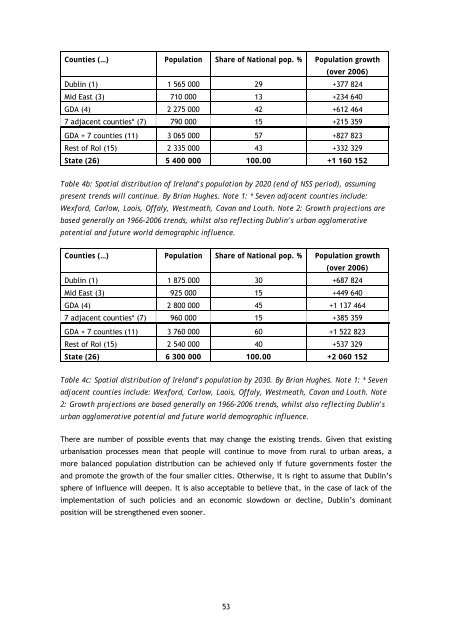TWICE THE SIZE - DIT Update - Dublin Institute of Technology
TWICE THE SIZE - DIT Update - Dublin Institute of Technology
TWICE THE SIZE - DIT Update - Dublin Institute of Technology
Create successful ePaper yourself
Turn your PDF publications into a flip-book with our unique Google optimized e-Paper software.
Counties (…) Population Share <strong>of</strong> National pop. % Population growth<br />
53<br />
(over 2006)<br />
<strong>Dublin</strong> (1) 1 565 000 29 +377 824<br />
Mid East (3) 710 000 13 +234 640<br />
GDA (4) 2 275 000 42 +612 464<br />
7 adjacent counties* (7) 790 000 15 +215 359<br />
GDA + 7 counties (11) 3 065 000 57 +827 823<br />
Rest <strong>of</strong> RoI (15) 2 335 000 43 +332 329<br />
State (26) 5 400 000 100.00 +1 160 152<br />
Table 4b: Spatial distribution <strong>of</strong> Ireland’s population by 2020 (end <strong>of</strong> NSS period), assuming<br />
present trends will continue. By Brian Hughes. Note 1: * Seven adjacent counties include:<br />
Wexford, Carlow, Laois, Offaly, Westmeath, Cavan and Louth. Note 2: Growth projections are<br />
based generally on 1966-2006 trends, whilst also reflecting <strong>Dublin</strong>’s urban agglomerative<br />
potential and future world demographic influence.<br />
Counties (…) Population Share <strong>of</strong> National pop. % Population growth<br />
(over 2006)<br />
<strong>Dublin</strong> (1) 1 875 000 30 +687 824<br />
Mid East (3) 925 000 15 +449 640<br />
GDA (4) 2 800 000 45 +1 137 464<br />
7 adjacent counties* (7) 960 000 15 +385 359<br />
GDA + 7 counties (11) 3 760 000 60 +1 522 823<br />
Rest <strong>of</strong> RoI (15) 2 540 000 40 +537 329<br />
State (26) 6 300 000 100.00 +2 060 152<br />
Table 4c: Spatial distribution <strong>of</strong> Ireland’s population by 2030. By Brian Hughes. Note 1: * Seven<br />
adjacent counties include: Wexford, Carlow, Laois, Offaly, Westmeath, Cavan and Louth. Note<br />
2: Growth projections are based generally on 1966-2006 trends, whilst also reflecting <strong>Dublin</strong>’s<br />
urban agglomerative potential and future world demographic influence.<br />
There are number <strong>of</strong> possible events that may change the existing trends. Given that existing<br />
urbanisation processes mean that people will continue to move from rural to urban areas, a<br />
more balanced population distribution can be achieved only if future governments foster the<br />
and promote the growth <strong>of</strong> the four smaller cities. Otherwise, it is right to assume that <strong>Dublin</strong>’s<br />
sphere <strong>of</strong> influence will deepen. It is also acceptable to believe that, in the case <strong>of</strong> lack <strong>of</strong> the<br />
implementation <strong>of</strong> such policies and an economic slowdown or decline, <strong>Dublin</strong>’s dominant<br />
position will be strengthened even sooner.








